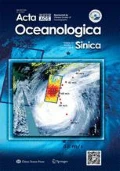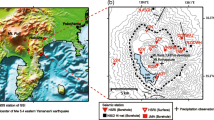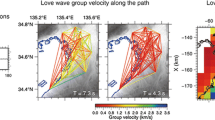Abstract
Seismic monitoring using ocean bottom seismometers (OBS) is an efficient method for investigating earthquakes in mid-ocean ridge far away from land. Clock synchronization among the OBSs is difficult without direct communication because electromagnetic signals cannot propagate efficiently in water. Time correction can be estimated through global positioning system (GPS) synchronization if clock drift is linear before and after the deployment. However, some OBSs in the experiments at the southwest Indian ridge (SWIR) on the Chinese DY125-34 cruise had not been re-synchronized from GPS after recovery. So we attempted to estimate clock drift between each station pairs using time symmetry analysis (TSA) based on ambient noise cross-correlation. We tested the feasibility of the TSA method by analyzing daily noise cross-correlation functions (NCFs) that extract from the data of another OBS experiment on the Chinese DY125-40 cruise with known clock drift and the same deployment site. The results suggest that the NCFs’ travel time of surface wave between any two stations are symmetrical and have an opposite growing direction with the date. The influence of different band-pass filters, different components and different normalized methods was discussed. The TSA method appeared to be optimal for the hydrophone data within the period band of 2–5 s in dozens of km-scale interstation distances. A significant clock drift of ~2 s was estimated between OBSs sets through linear regression during a 108-d deployment on the Chinese cruise DY125-34. Time correction of the OBS by the ambient noise cross-correlation was demonstrated as a practical approach with the appropriate parameters in case of no GPS re-synchronization.
Similar content being viewed by others
References
Aster R C, McNamara D E, Bromirski P D. 2008. Multidecadal climate-induced variability in microseisms. Seismol Res Lett, 79(2): 194–202
Bensen G D, Ritzwoller M H, Barmin M P, et al. 2007. Processing seismic ambient noise data to obtain reliable broad-band surface wave dispersion measurements. Geophys J Int, 169(3): 1239–1260
Campillo M. 2006. Phase and correlation in ‘random’ seismic fields and the reconstruction of the Green function. Pure Appl Geophys, 163(2–3): 475–502
Dolenc D, Romanowicz B, Stakes D, et al. 2005. Observations of infragravity waves at the Monterey ocean bottom broadband station (MOBB). Geochem Geophys Geosyst, 6(9): Q09002
Gardner A T, Collins J A. 2012. Advancements in high-performance timing for long term underwater experiments: A comparison of chip scale atomic clocks to traditional microprocessor-compensated crystal oscillators. In: IEEE Oceans. Hampton Roads, VA, USA: IEEE, doi: 10.1109/OCEANS.2012.6404847
Gouedard P, Seher T, McGuire J J, et al. 2014. Correction of oceanbottom seismometer instrumental clock errors using ambient seismic noise. Bull Seismol Soc Am, 104(3): 1276–1288
Hannemann K, Kruger F, Dahm T. 2014. Measuring of clock drift rates and static time offsets of ocean bottom stations by means of ambient noise. Geophys J Int, 196(2): 1034–1042
Larose E, Derode A, Campillo M, et al. 2004. Imaging from one-bit correlations of wideband diffuse wave fields. J Appl Phys, 95(12): 8393–8399
Liu Yunlong, Tao Chunhui, Liu Cai, et al. 2018. Seismic activity recorded by a single OBS/H near the active Longqi hydrothermal vent at the ultraslow spreading Southwest Indian Ridge (49°39'E). Mar Geores Geotechnol: doi: 10.1080/1064119X.2017. 1420114
Pontbriand C W, Sohn R A. 2014. Microearthquake evidence for reaction-driven cracking within the Trans-Atlantic Geotraverse active hydrothermal deposit. J Geophys Res: Solid Earth, 119(2): 822–839
Ruan Aiguo, Li Jiabiao, Chen Yongshun, et al. 2010. The experiment of broad band 1–4C type OBS in the Southwest Indian Ridge. Chin J Geophys (in Chinese), 53(4): 1015–1018
Sabra K G, Roux P, Thode A M, et al. 2005. Using ocean ambient noise for array self-localization and self-synchronization. IEEE J Ocean Eng, 30(2): 338–347
Schlindwein V, Schmid F. 2016. Mid-ocean-ridge seismicity reveals extreme types of ocean lithosphere. Nature, 535(7611): 276–279
Sens-Schönfelder C. 2008. Synchronizing seismic networks with ambient noise. Geophys J Int, 174(3): 966–970
Shapiro N M, Campillo M, Stehly L, et al. 2005. High-resolution surface-wave tomography from ambient seismic noise. Science, 307(5715): 1615–1618
Stehly L, Campillo M, Shapiro N M, et al. 2006. A study of the seismic noise from its long-range correlation properties. J Geophys Res: Solid Earth, 111(B10): B10306
Stehly L, Campillo M, Shapiro N M. 2007. Traveltime measurements from noise correlation: stability and detection of instrumental time-shifts. Geophys J Int, 171(1): 223–230
Stroup D F, Tolstoy M, Crone T J, et al. 2009. Systematic along-axis tidal triggering of microearthquakes observed at 9°50'N East Pacific Rise. Geophys Res Lett, 36(18): L18302
Tao Chunhui, Li Huaiming, Jin Xiaobing, et al. 2014. Seafloor hydrothermal activity and polymetallic sulfide exploration on the southwest Indian ridge. Chin Sci Bull, 59(19): 2266–2276
Tao Chunhui, Lin Jian, Guo Shiqin, et al. 2012. First active hydrothermal vents on an ultraslow-spreading center: Southwest Indian Ridge. Geology, 40(1): 47–50
Webb S C, Zhang Xin, Crawford W. 1991. Infragravity waves in the deep ocean. J Geophys Res, 96(C2): 2723–2736
Yao Huajian, Van Der Hilst R D, De Hoop M V. 2006. Surface-wave array tomography in SE Tibet from ambient seismic noise and two-station analysis: I. Phase velocity maps. Geophys J Int, 166(2): 732–744
Yao Huajian, Gouédard P, Collins J A, et al. 2011. Structure of young East Pacific Rise lithosphere from ambient noise correlation analysis of fundamental- and higher-mode Scholte-Rayleigh waves. Comptes Rendus Geosci, 343(8–9): 571–583
Acknowledgements
The authors thank the captain and the crew of CDC 34th and 40th for their efforts to complete the development of the OBSs.
Author information
Authors and Affiliations
Corresponding author
Additional information
Foundation item: China Ocean Mineral Resources R & D Association Major Project under contract No. DY135-S1-01; the National Natural Science Foundation of China under contract Nos 41506078, 41706042 and 41522404; the Basic Research Foundation of Second Institute of Oceanography, SOA under contract No. JG0608.
Rights and permissions
About this article
Cite this article
Liu, Y., Liu, C., Tao, C. et al. Time correction of the ocean bottom seismometers deployed at the southwest Indian ridge using ambient noise cross-correlation. Acta Oceanol. Sin. 37, 39–46 (2018). https://doi.org/10.1007/s13131-018-1209-1
Received:
Accepted:
Published:
Issue Date:
DOI: https://doi.org/10.1007/s13131-018-1209-1




